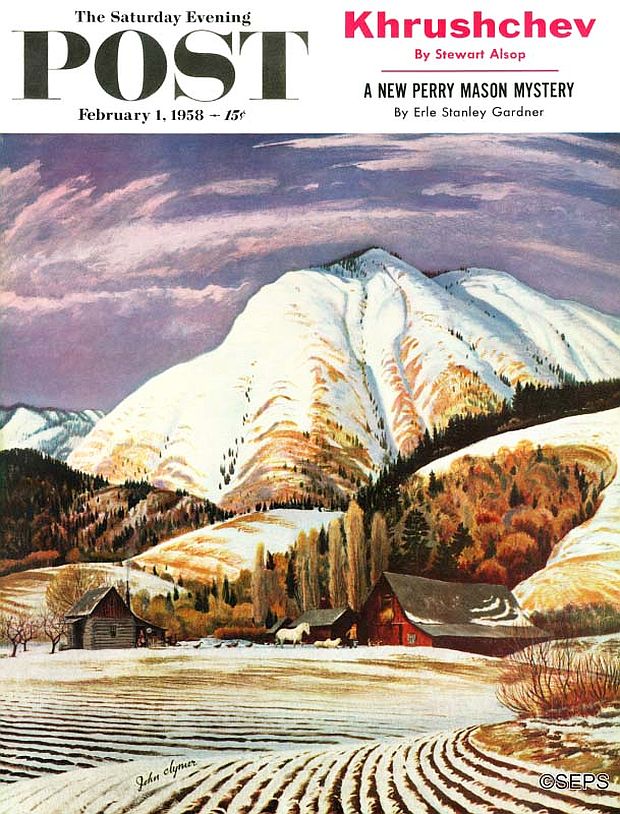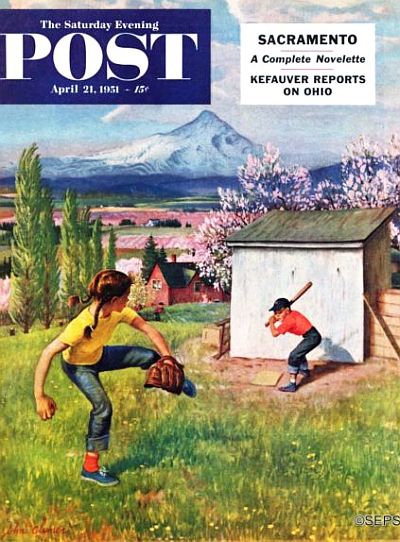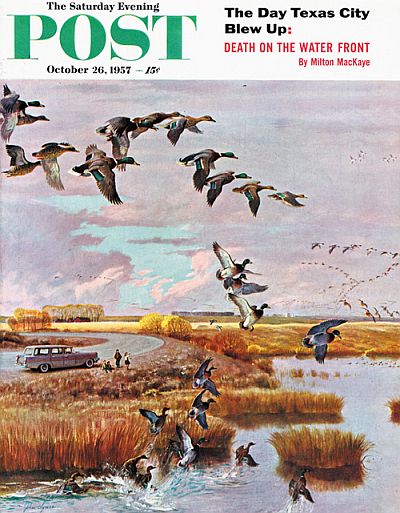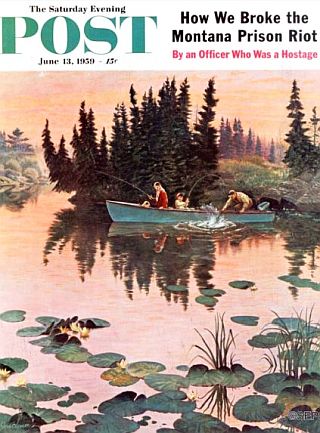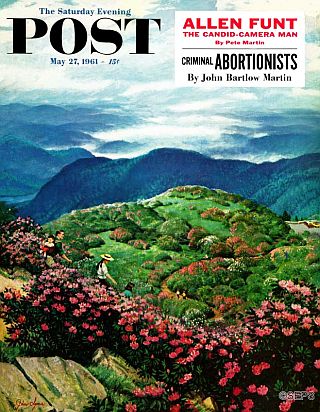Never mind the headline for the Marilyn Monroe story that appears at the top of the May 5th, 1956 Saturday Evening Post magazine cover shown below. With all due respect to Ms. Monroe and her beauty, the main topic that follows is not about her, but rather, another kind of beauty, celebrated here in the works of painter/illustrator, John Clymer. The offering below is one of the more than 80 cover illustrations Clymer rendered for the Saturday Evening Post during his career there from 1942 to 1962. What follows is a sampling of Clymer’s work at the Saturday Evening Post and a few other places, as well as some background on his life and career.
The work above is titled, “Rocky Mountain Fly Fishing,” which is more about the grandeur of the American landscape Clymer has captured here than it is about fishing. Clymer, in fact, was partial to landscapes, and often, as here, western landscapes with mountains. This one has its “purple mountains majesties” along with forested hillsides and bountiful meadows. But it also shows, in the lower right hand corner, a lone fishermen; a local rancher perhaps, who just gotten off his horse and is now mid-stream doing a little fly fishing. But Clymer here, as in his other works of this kind, relegates the human figure to scale on this landscape, appearing small and almost beside the point; inconsequential before the majestic natural world he is privileged to be enjoying. In other works, however, as in the one below, Clymer places human figures more at the center of the composition, though typically in a setting where they too are enjoying nature.
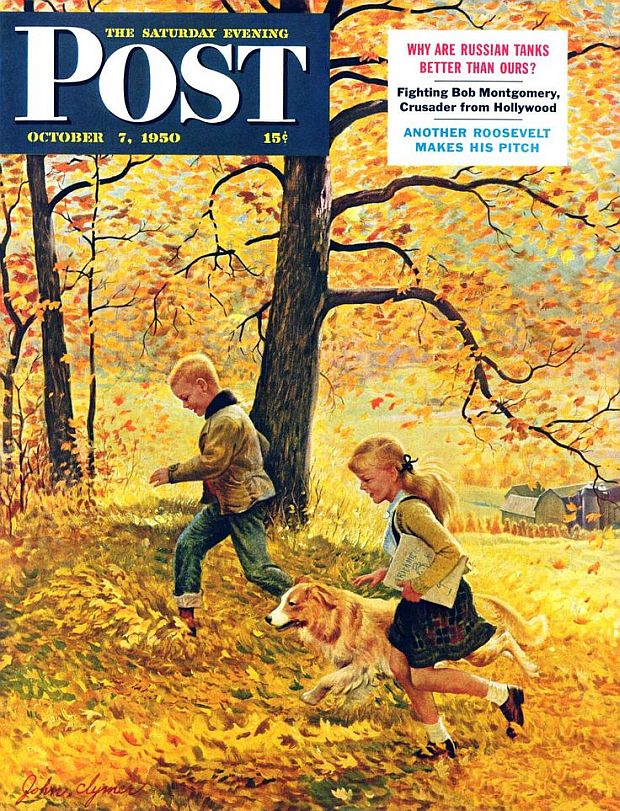
October 7, 1950: “Walking Home Through Leaves.” Illustrator John Clymer captures the essence of an autumn scene for “The Saturday Evening Post” with school kids and dog charging through fallen leaves.
John Clymer was one of those “old fashioned” magazine illustrators; those who drew and painted scenes from what today might seem like another world – the 1940s and 1950s. These artists were capturing American beauty and America culture of those years – published weekly by one of the nation’s most read and trusted magazines, The Saturday Evening Post, selling 2 million or more copies a week in the mid-1950s – sort of an oversized iPhone of its time. But this body of work by Clymer and other illustrators – and generously displayed on the large 11″ x 17″ magazine format of that era – also marks a kind of cultural history; a conveyance of American values from those times, and not least, some media history as well.

September 21, 1957. John Clymer’s, “Ride ‘Em Cowboy.” Another western landscape with dramatic mountains, streams of sunlight, and young children at play – the latter of which frequently appear in a number of his covers. Yet, again, the natural world is the star.
John Ford Clymer was born in Ellensburg, Washington – in the foothills of the Cascade Mountains. And it would be in this environment of Pacific Northwest wilderness, that Clymer would develop his eye for natural beauty and a love of the outdoors. His parents, Elmira and John P. Clymer, were early settlers to the area, building and operating a greenhouse and florist business. However young John wasn’t the best school student in those days, as long hours in a classroom bored him. Summer vacations and after school hours spent exploring the natural world in his native land were his happiest times – and these experiences would be stored away in Clymer’s memory banks, later taking form on canvas and magazine covers.
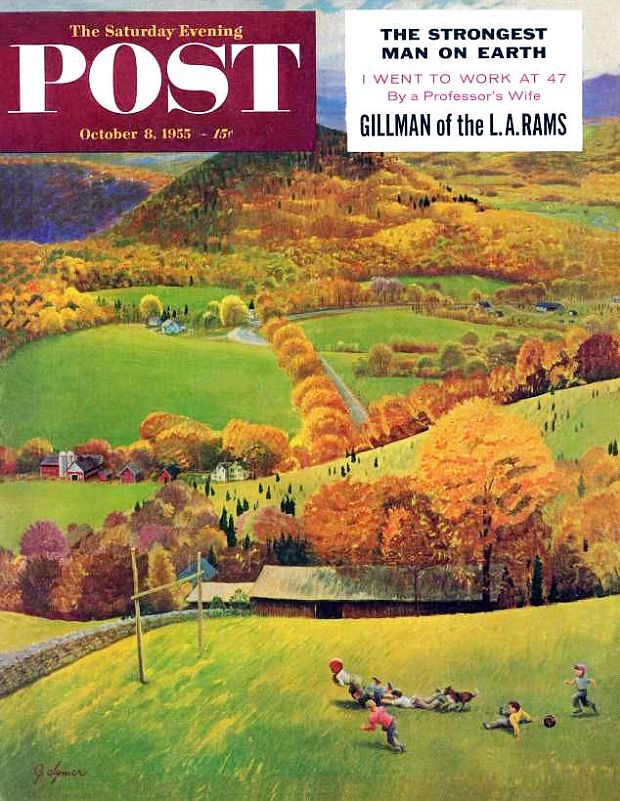
October 8, 1955. “Football in the Country.” Another of John Clymer's expansive, colorful landscapes at fall, with boy footballers seemingly oblivious to the grandeur all around them.
As John Clymer was growing up, traveling magazine salesman would come by the Clymer home from time to time selling magazine subscriptions. Cosmopolitan, Good Housekeeping and Hearst’s International magazines, were among the offerings. Young John occasionally flipped through the magazines. One day he came across a double-page illustration by an artist named Walt Louderback. He had never seen a picture like it before. Other magazines of that time were filled with equally interesting illustrations by Dean Cornwell, N. C. Wyeth, Frank Schoonover and others. This was a world of art John never knew existed. He became a regular at local newsstands, seeking out the latest magazines, and whenever new issues came out he studied what the artists and illustrators of that day were offering. He became especially enamored of the work of Louderback, and also discovered other illustrators, including those of the Brandywine School of artists, of the Southeastern Pennsylvania / Wilmington, Delaware area — N.C. Wyeth and others.
Soon he began to ponder the possibilities for art education, and around the age of 12 or 13 he took a correspondence course and spent his free time working toward this goal. Several of Clymer’s high school teachers noticed his potential and determination, and encouraged his interest. By the time he was 16 he had sold his first two illustrations to Colt Firearms Company in Hartford, Connecticut. The Colt illustrations were used for advertisements, and in fact, published many times. While still in high school, he also produced promotional advertising for the Ellensburg, Washington rodeo.
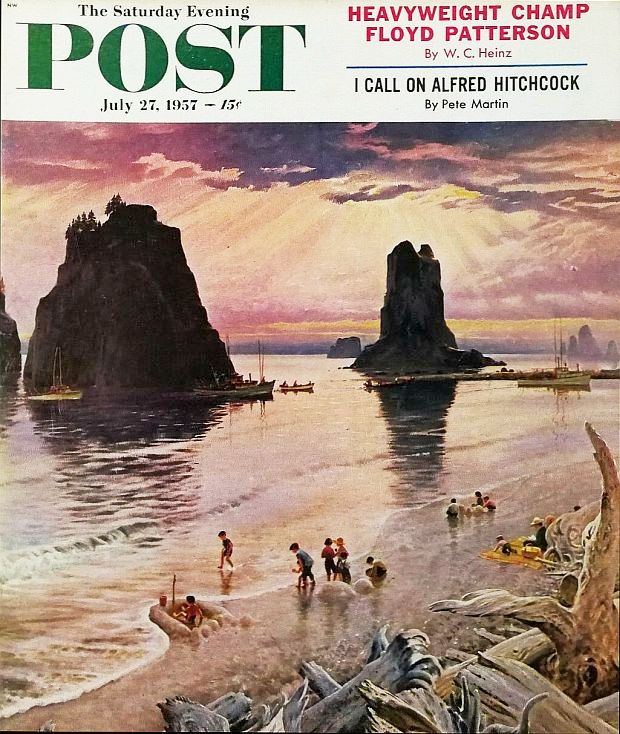
July 27, 1957. “Pacific Ocean Sunset,” one of John Clymer’s most dramatic covers set along the coastline of Northwest Washington near the town of La Push. Offshore rocky island spires there, some rising 200 feet or more, give a unique and dramatic character to the scene that Clymer renders here, capturing a special light at sunset with returning fishing boats and various beach visitors. Some of the offshore formations – rising like rocky cathedrals – are regarded as sacred by the indigenous Quileute people. Today, this coastal area is protected as part of the Olympic Wilderness system.
After high school, Clymer moved to Canada and worked as an illustrator for billboards and as a sign painter in Vancouver, where in his early 20’s he took art classes at night for a time. He also studied at the Vancouver School of Fine Art and then at the Ontario College of Art. As a young man, Clymer traveled throughout the Northwest and Canada, immersing himself in the environments and subjects he loved most in those regions, and would later come alive in his painting –– wildlife, wilderness, mountain men, trappers, and Indians.
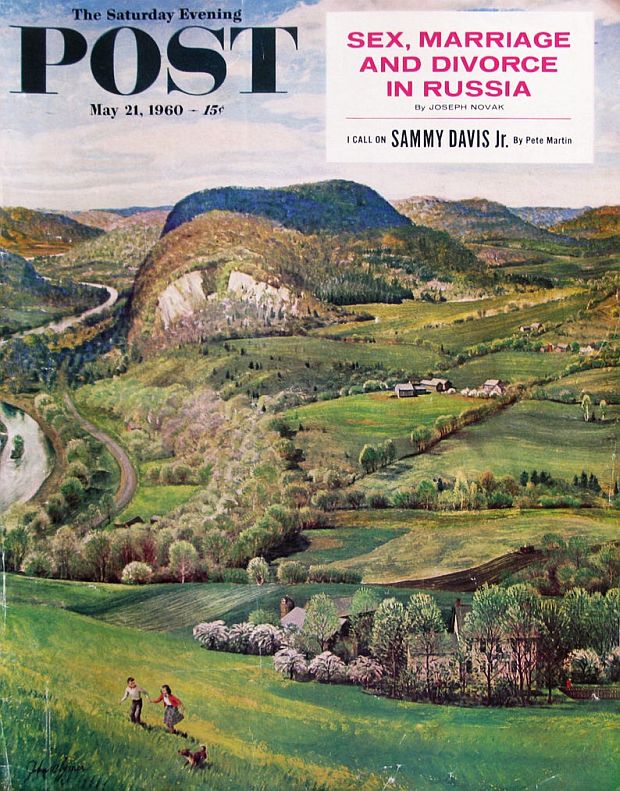
May 21, 1960, Saturday Evening Post cover titled, “Green Mountains.” John Clymer didn’t limit his fondness for landscapes to the West, also rendering scenes from the Eastern U.S., as here from Vermont. He also did other landscape scenes for the Post set in North Carolina, Kentucky, New Hampshire, Virginia, and Ohio.
In the summer of 1927, Clymer worked as a deckhand on a steamboat on the Yukon River and during that time he visited gold mines, river trading posts, and logging camps. Clymer had made his way to Alaska and then by rail White Horse, Yukon Territory, where he took up work on the wood-fired steamboat that ran a supply service. “Since there were no roads in there at the time, the only way into the interior was by the river,” Clymer recalled. “Our itinerary was to make round trips with supplies to the trading posts up three different tributaries of the Yukon: the Pelly, Stewart and Teslin rivers.” These travels came at a time when the frontier landscapes of America and Canada were yielding to the inroads of civilization. So in these and later travels, young John Clymer was drinking in what he saw and experienced, to be drawn upon from memory in later years.
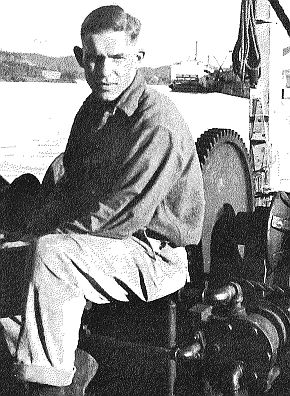 1927. John Clymer, a 20 year-old deckhand on trading & supply steamboat on Yukon Territory rivers. |
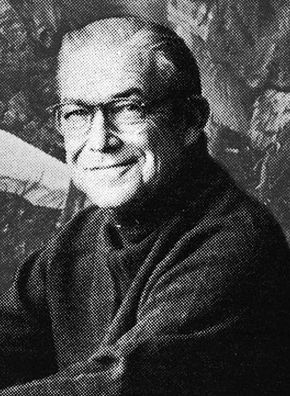 John Clymer in later years, by then working mostly on art of the American West and Native Americans. |
In the late 1920s, Clymer also visited with artist Frank Schoonover in the Brandywine River area of Pennsylvania, who encouraged him to study in Wilmington. By 1930, Clymer was a student at the Wilmington Academy in Delaware, where he was strongly influenced by N.C. Wyeth and Wyeth’s students: Gayle Hoskins, Stanley Arthurs, and Douglas Duer. Two years later, in 1932, he married his childhood sweetheart, and by the fall of 1937, he and his wife Doris moved to Westport, Connecticut, the location from which he would establish his career, as an illustrator for American magazines, including Argosy, The Saturday Evening Post, Woman’s Day, True, and Field and Stream.

September 9, 1961. “Roadside Vegetable Stand,” by John Clymer, has a bit of an impressionistic look. Set in New Hampshire, Clymer captures a summery-like autumn day, with leave-changing yellows abounding as a touch of green still hangs on. Meanwhile, a rain shower and darkening clouds move in across the hills beyond the lake, as roadside customers come and go at the vegetable stand.
In Westport, Clymer joined an artists colony, where he studied with Harvey Dunn, and later at the Grand Central School of Art in New York city. The illustrator, Walt Louderback remained his hero, although he was much impressed by the work of Dean Cornwell and NC Wyeth. In addition to his Saturday Evening Post work, Clymer also painted calendars every year for 28 years for the American Cyanamid Co., a major chemical company, and did an advertising series for the New England Life Insurance Company. Other advertising work included paintings for White Horse Scotch Whisky, the Pennsylvania Railroad, and the Chrysler Corporation.
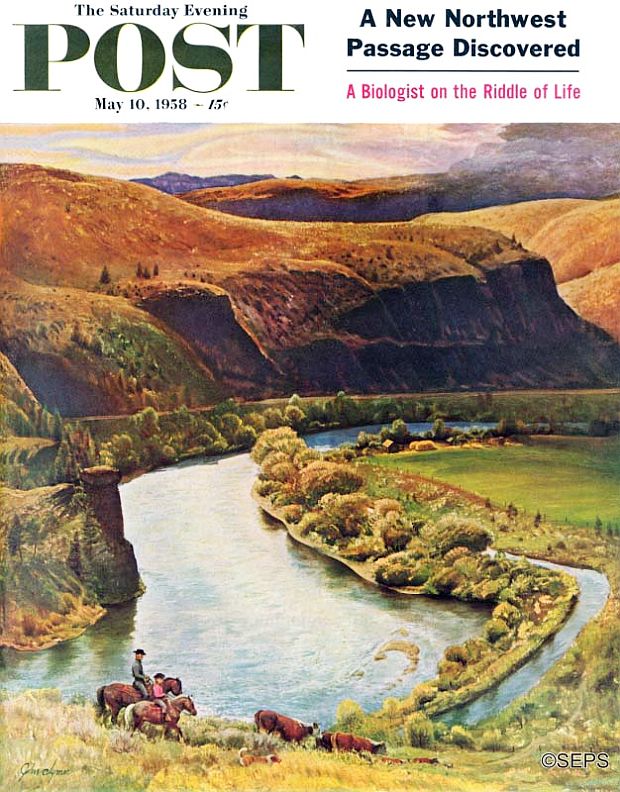
February 1, 1958. “Yakima River Cattle Roundup” shows the Yakima River in Washington, not far from John Clymer’s boyhood home in Ellensburg. An irrigation canal appears on the right, and the bluffs beyond are quite stunning. Reportedly, at this river bend, not far from old U. S. Route 10, Clymer and his father often fished for trout.
By the early 1940s, Clymer scored his first illustration for a Saturday Evening Post cover, shown below right. Later interviewed by Walt Reed, who published 1976 biography on Clymer, the artist recalled his beginnings at the Post:
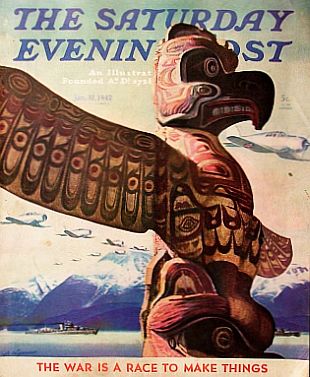
January 31, 1942. John Clymer’s first cover for “The Saturday Evening Post” is published, titled, “Totem Pole.”
…Just before the war I had done my first Post cover, an Alaska inland passage subject with a totem pole in the foreground, U.S. Navy destroyers and aircraft in the background. On a visit back home, out at Ellensburg, I noticed my young son, David, peering into a hole in an old poplar stump, looking for flickers nests. It immediately struck me as a good possibility for a Post cover. So I painted it, sent it in to them, and they bought it [“Boy on A Horse” cover, July 30, 1949 edition, see below], saying they’d like to see a sketch for another idea. So I began to do a long series of Post covers — approximately 80 of them over the next dozen years. My approach was to look for human interest subjects and then try to place them in a proper setting to fit the idea. Sometimes it would take a long time to bring the two elements together. One early idea involved a young boy playing in an abandoned auto chassis, but I couldn’t figure out how to present it. Two years later, while driving through Jackson Hole in Wyoming, I noticed some old, rusty farm machinery in the corner of a field. It then struck me that this was a perfect spot for the old car. A Western boy would be brought up on horseback riding, but when he spotted the old auto body, he ceased to be a cowboy and was transformed into a hot rod driver (see the two final covers Clymer described below).
During World War II, Clymer and his friend from Westport, illustrator Tom Lovell, joined the Marines together (went through boot camp at age 36), and Clymer’s Saturday Evening Post career was interrupted. Too old for action, they were stationed in Washington, D.C. and spent the war painting illustrations for the Marine Corps Gazette and Leatherneck magazine. After Clymer was discharged in 1945, he rejoined The Saturday Evening Post and started doing covers once again, more than 80 of which would follow.
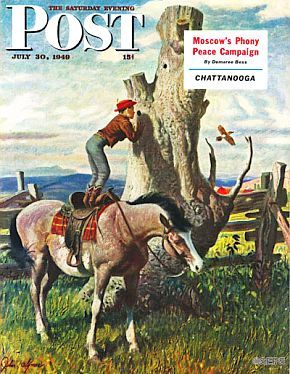 July 30, 1949 cover, “Boy on a Horse,” the idea for which came to Clymer after seeing his son inspecting a hole in a tree stump looking for flicker nests. |
Continuing his remarks to Walt Reed, Clymer also noted the scrutiny Post covers received from the magazine’s readers:
“…There was only one drawback about doing covers for the Post. They went everywhere in the country, and because I picked and painted actual places, there would be several hundred people who lived nearby who’d scrutinize every detail to try to find something wrong. I had to be sure I knew all about everything included in a picture, and why it was there. There would always be someone like a telephone lineman who’d write in and say, ‘I don’t think that was the kind of insulator they used in that area.’ The Post was good about those things. The only time I had to make a correction on a cover was when I sent in a picture that had an automobile in the foreground. I had completed everything, lights, chrome, trim, spokes, but forgot to paint in the door handle.”
Clymer would also state about his work that he always tried to take the viewer “to an actual place and make him feel that he was really there.” Creating cover art for The Saturday Evening Post was a four-step process: a field sketch, a charcoal sketch, the oil painting, then a plate was made from a photograph of the original. The sketches were generally approved by the editor before the oil stage was reached. In describing his working process, Clymer in his own words, noted: “The sketch gives you the feel, but the photo gives you the facts. Next, make a small oil on canvas for the mood. Then comes the finished painting, where you emphasize the beautiful and wonderful and leave everything else out…”
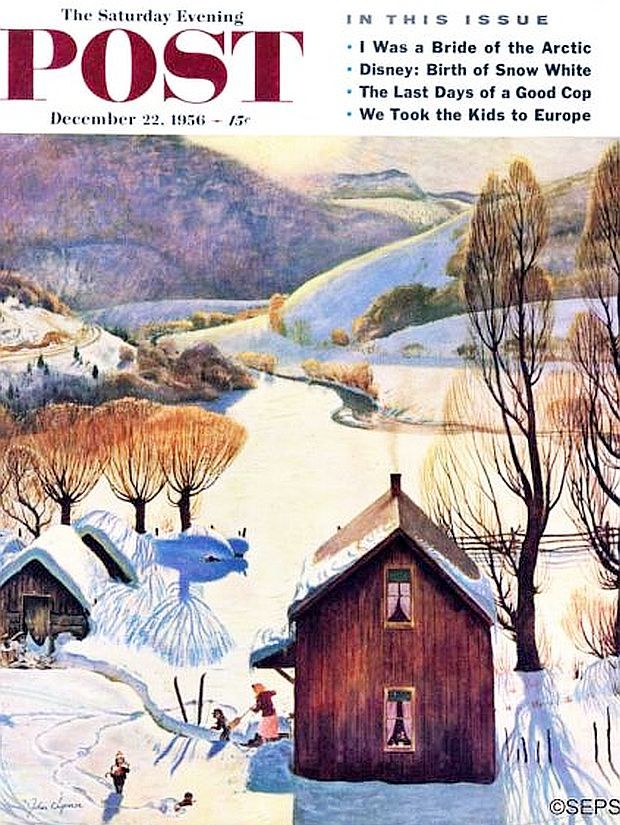
December 22, 1956. John Clymer, in this Saturday Evening Post cover, titled “Snow on The Farm,” has captured a snowy, wintry scene that has the feel of a fading, late afternoon December sun, which is directly ahead behind the mountain, casting long shadows from the trees and farmhouse, as “Mom” appears to be brooming off one of the youngsters.
In any case, the magazine art of that era – at least at a few publications like The Saturday Evening Post – had a way of reminding Americans through weekly cover illustrations from artists like John Clymer, John Falter, Stevan Dohanos, and others, what a beautiful country they had, whether in the natural majesty of the wide-open west, or nature’s color and light just out the window or down the street. The magazine illustrators of that time, like John Clymer, helped capture that beauty, and in the process, left a legacy of great landscapes, homage to America the Beautiful, and also, some “good-old-days” nostalgia of a by-gone time. A listing and a few more samples of John Clymer’s work at The Saturday Evening Post follows below.
___________________________________
“Clymer’s Covers”
Saturday Evening Post, 1942-1962
Listing & Samples
 September 18, 1954, Saturday Evening Post, John Clymer cover, “Lasso Practice.” |
Cover Title & Date
“Totem Pole”
January 31, 1942
“Old Glory”
July 4, 1942
“Boy on Horse”
July 30, 1949
“Belgian Horse Farm”
October 8, 1949
“Winter Sleigh Ride”
December 17, 1949
“Tired Hiker”
April 15, 1950
“Apple Blossom Time”
May 6, 1950
“Feeding Fawn Near…”
May 27, 1950
“Dude Ranch Meal”
July 29, 1950
“Walking…Thr. Leaves”
October 7, 1950
“Ranch Basketball”
November 11, 1950
“Winter on the Farm”
December 30, 1950
“Gathering Wood”
January 27, 1951
“Barn Skiing”
February 17, 1951
“Oregon Baseball”
April 21, 1951
“Putting Up Birdhouses”
June 9, 1951
“Oregon or Bust”
August 4, 1951
“Colorado Creek”
October 13, 1951
“Apres Ski Bonfire”
February 23, 1952
“Hiking in Mountains”
May 31, 1952
“Herding Horses”
September 13, 1952
“Walk in the Forest”
October 18, 1952
“Quarterback in…Tub”
November 15, 1952
“Jumping Rope…”
April 25, 1953
“Feeding Chipmunks”
May 16, 1953
“Feeding the Elephants”
July 25, 1953
“Town Green”
August 15, 1953
“Children W/ Rowboat”
October 31, 1953
“Deep Snow Fall”
January 23, 1954
“Rural Wedding”
May 29, 1954
“Picnic On Mt. Rainier”
July 17, 1954
“Lasso Practice”
September 18, 1954
“Leaf Pile”
October 16, 1954
“Tobogganing”
January 22, 1955
“Harbinger of Spring”
May 7, 1955
“Dog Days of Summer”
June 25, 1955
“Blueberry Hill”
August 13, 1955
“Football in the Country”
October 8, 1955
“Thanksgiving on…Farm”
November 26, 1955
“Cutting Down the Tree”
December 17, 1955
“Snowball Recess”
February 4, 1956
“Kite in the Tree”
March 10, 1956
“Two Little Dears”
August 25, 1956
“Fall Horseback Ride”
October 20, 1956
“Snow on the Farm”
December 22, 1956
“Mountain Farm”
March 23, 1957
“Skipping Stones”
June 22, 1957
“Pacific Ocean Sunset”
July 27, 1957
“Ride ‘Em Cowboy”
September 21, 1957
“South for the Winter”
October 26, 1957
“Bringing Home the Tree”
December 21, 1957
“Cascade Mnt. Farm”
February 1, 1958
“Yakima Riv…Roundup”
May 10, 1958
“Following The Leader”
September 27, 1958
“Fall Photo Op”
October 25, 1958
“Ice Hockey on Mt. Pond”
December 13, 1958
“Abandoned Equipment”
May 23, 1959
“A Fine Catch”
June 13, 1959
“Portage Glacier”
July 25, 1959
“Swimming in the Creek”
August 29, 1959
“Blue Ridge Burro Ride”
October 10, 1959
“Gloucester Harbor”
November 14, 1959
“Iceboating”
November 28, 1959
“Snow… at Snoqualmie…”
February 6, 1960
“Recess at Pine Creek”
April 2, 1960
“Green Mountains”
May 21, 1960
“Zion Canyon”
July 9, 1960
“Horseback…Glacier Pk”
July 30, 1960
“Sheep Ranch”
March 18, 1961
“Ohio River in April”
April 15, 1961
“Appalachian [Rhodies]”
May 27, 1961
“Green KY Pastures”
July 29, 1961
“Roadside Veg. Stand”
September 9, 1961
“Spring Warms…Mnts.”
May 5, 1962
“Walking… in the Rain”
October 20, 1962
______________________________________
Western Art
In 1964, John Clymer began to explore a second chapter of his art career, this time painting scenes from the Old West and Native Americans. Western art collectors at that time were taking an interest in historic paintings by living artists. Clymer and his wife Doris would move to Jackson Hole, Wyoming where John began a focus on painting, working on wildlife scenes at first, and later, historic western art of the early 19th century Great Plains and Rocky Mountain regions. Doris encouraged him on that latter front, and the pair teamed up in the enterprise. They did detailed research on the proposed historical subjects and visited sites to get a first-hand feel for the area. The attention to historic detail paid off, as Clymer would collect a number of awards for his western art, some of it also published as illustrations for textbooks and historical documentaries.

1977 book, “The Western Paintings of John Clymer,” with introduction by Paul Weaver, published by Bantam Books, New York; 98pp, with 46 full-page color plates and 4 black & white illustrations. Click for copy.
John Clymer had long-standing interest in his home territory, the Pacific Northwest, and its history. One of his featured subjects was the great fur trade era. He also did a series on Lewis & Clark and their exploration of the region, covering the role of Sacagawea, an Indian interpreter and wife of a French scout on the journey. One of his paintings is titled, “Sacagawea At The Big Water,” depicting the first time Sacagawea had seen the ocean. Clymer also had a special interest in Northwest Coastal tribes, and as a boy he had been exposed at home to an old Indian visitor and friend of the family. Another of his subjects was Chief Joseph of the Nez Perce. His Indian works often revealed little known details of Native American life and practices, as in “Breaking Wild Horses,” which depicts young Indian braves cleverly breaking and taming wild horses while riding them in shoulder-deep river water.
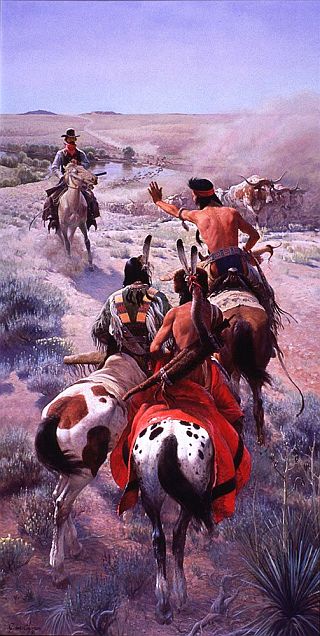
John Clymer’s “The Cattle Drive,” one of 3 works in the Winchester-sponsored series completed in 1969-70.
In 1969, John Clymer was commissioned by the Olin Corporation (then the parent company of the Winchester Repeating Rifle Co,) to create three large paintings that featured Winchester rifles – rifles that company advertising for decades had described as “guns that won the West.”
One of the Clymer paintings depicted a scene around the time of the 1859 gold rush, titled “The Gold Train,” showing a line of gold-laden mules descending Colorado hills led by a guard on horseback holding a Henry repeating rifle.
A second painting, titled “The Home-steaders,” features a homestead family with wagon crossing Wyoming territory as the father on foot leads a boy on horseback ahead of the wagon, holding a Winchester rifle in one hand as he goes.
The third of the Winchester paintings, shown at right, is set near the Rawhide Creek crossing of the Platte River in then-Nebraska Territory during the mid-1860s. Clymer titled this painting, “The Cattle Drive,” and the dust from the thundering herd of Texas longhorns is seen rising from the distant trail. This cattle drive is heading to Montana grazing land.
But in this rendering the trail boss on horseback, with Winchester rifle across his saddle, is confronted by a group Sioux warriors.
Left to conjure here is what sort of negotiations and resolution might have followed between the parties depicted. It is also one of many “how-the-West-was-settled” renderings that raise questions about the expropriation of Native American lands.
All three of Clymer’s Winchester paintings (each of which measures nearly five feet by ten feet), were first dedicated in March 1970 at the 21 Club in New York City, and now reside in the Cody Firearms Museum, which is one of five museums under one roof at The Buffalo Bill Center of the West in Cody, Wyoming.
John Clymer’s works on early Western exploration and the fur trade, as sampled below, were also quite good and typically very accurate, offering important details and historic fact. A number of Clymer’s Western and Indian paintings are pictured with explanations at The Eddie Basha Collection.
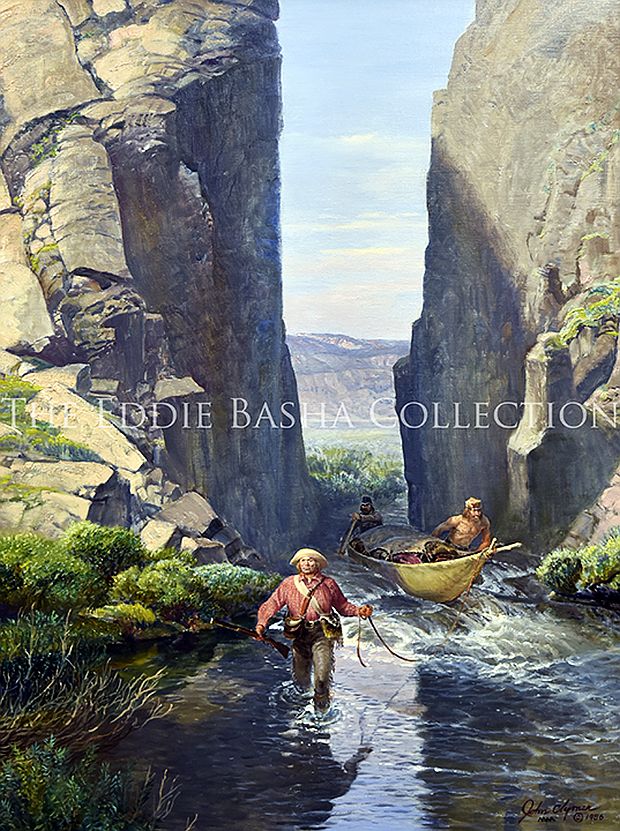
“Devil's Gate: Fitzpatrick 1824,” painted by John Clymer in 1986, shows fur trappers Thomas Fitzpatrick and companions after a winter of trapping in Montana and Idaho passing through a notch in the hills called Devil’s Gate in an attempt to float their wares down a series of rivers to St. Louis, only to be stymied by shallow water later. Click for The Eddie Basha Collection.
At John Clymer’s passing in 1989, the Los Angeles Times noted that in 1978, when Clymer was in his 70s, some 282 people took part in a drawing at the Cowboy Artists of America art show in Phoenix for the right to pay $30,000 for one of his paintings: “Water, Water–Overland Astorians 1811,” an oil painting of a Western expedition financed by John Jacob Astor. That painting depicts the expedition finding creek water after a long, dry overland crossing. There was also some competitive bidding for another Clymer painting at the same auction the following year – this time for his “Roast Rabbit” painting – also sold in a drawing for $40,000, only to be resold a few minutes later to a losing bidder who paid the winner $55,000. But that was in the 1970s.
In more recent years, Clymer’s works – both of the Western variety, and some of his Saturday Evening Post paintings – have fetched even higher prices. In November 2012, for example, “The Raiding Party” sold for $194,500, as posted by Heritage Auctions. In November 2016, two of Clymer’s Western paintings topped the Leslie Hindman Auctioneers art sale in Denver – “Stalking Buffalo” (Indians camouflaged in wolf skins sizing up the prey), sold to the floor for $161,000, and “The Wild Land” (Grizzly bear standing over a taken-down Elk, 1967), sold to a phone bidder for $81,250. In addition, the Jackson Hole Art Auction website shows about two dozen John Clymer paintings – Western, Indian, and wildlife – that have been listed at auction in the 2007-2018 period, some selling for more than $350,000. Similarly, the Coeur d’Alene Art Auction has also listed a number of John Clymer paintings, including a few of his Saturday Evening Post covers, that have sold at auction in the $100,000 to $500,000 range.

“Bears on Tundra Pond” by John Clymer, shows bears emerging from a harsh winder on the Alaskan tundra.
In addition to his Western and Native American art, a number of Clymer’s wildlife and big game paintings – of bear, mountain goats, buffalo, etc. – are also quite stunning. Clymer’s eye for landscapes, however, still shone through in many of his Indian, trapper, frontier, and wildlife paintings.
Clymer received the Franklin Mint Gold Medal for Western Art in 1973 and the Gold Medal in Oil from the National Academy of Western Art in 1974. He was named to the New York Society of Illustrators Hall of Fame in 1982, and was featured on the PBS program “Profiles in American Art” in 1984. His works have been widely exhibited in various shows, auctions, and museums over the years. A more complete listing of his honors and exhibits can be found at the John Clymer Museum website.
The Saturday Evening Post, meanwhile – and its millions of readers – were lucky to have had John Clymer’s particular talents and vision for depicting the American landscape during the 1950s and early 1960s.
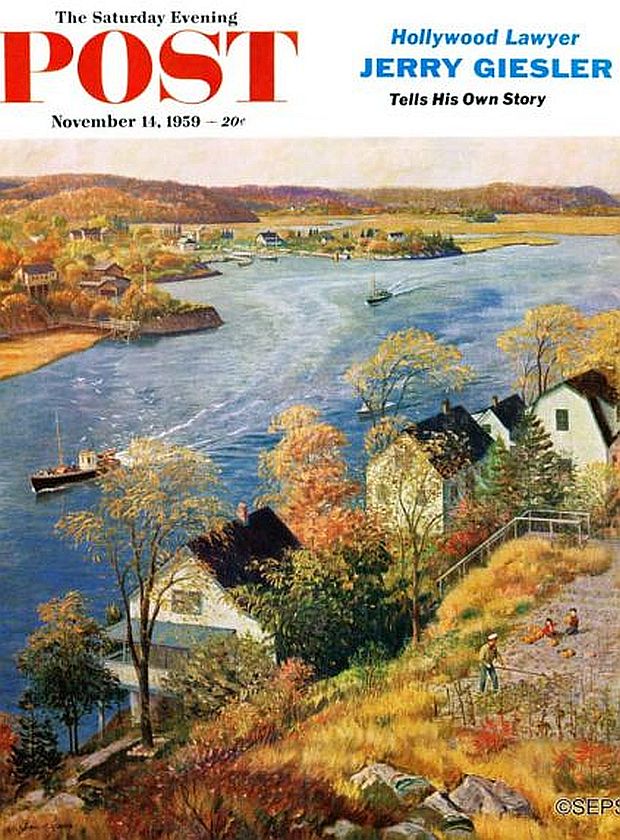
November 14, 1959, Saturday Evening Post cover, “Gloucester Harbor,” by John Clymer depicts a colorful autumn scene at Gloucester, Massachusetts, with harbor, wetlands and some surrounding hills in view, as fishing boats move over the water and a harbor-side resident works at his garden. Click for copy.
Additional stories at this website covering other illustrators at The Saturday Evening Post include, for example: “Rosie The Riveter” (Norman Rockwell), “U.S. Post Office” (Stevan Dohanos), “Falter’s Art Rising” (John Falter), and, “Rockwell & Race.” Other related stories can be found at the “Magazine History” topics page.
Thanks for visiting – and if you like what you find here, please make a donation to help support the research, writing, and continued publication of this website. Thank you. – Jack Doyle
|
Please Support Thank You |
____________________________________
Date Posted: 30 March 2020
Last Update: 31 January 2021
Comments to: jdoyle@pophistorydig.com
Article Citation:
Jack Doyle, “John Clymer’s America: The Saturday
Evening Post,” PopHistoryDig.com, March 30, 2020.
____________________________________
Sources, Links & Additional Information
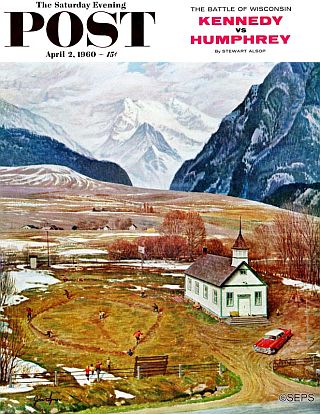 April 2, 1960. John Clymer’s subject here is “Recess at Pine Creek,” a one-room schoolhouse near Yellowstone National Park he had passed many times, but when painting the scene, he turned the schoolyard around so the Absaroaka Mountains would be the backdrop. |
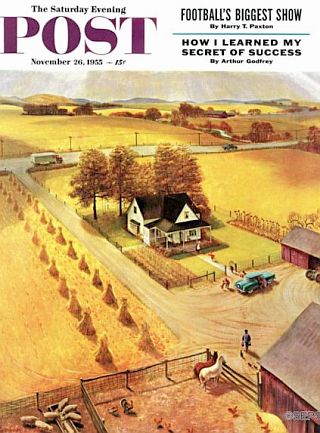 November 26, 1955, Saturday Evening Post, “Thanksgiving on the Farm,” by John Clymer. |
“John Ford Clymer (1907-1989),” Curtis Publishing.com.
John Ford Clymer Museum & Gallery, Ellesnburg, WA, ClymerMuseum.org.
John Clymer, AmericanIllustration.org.
“John Clymer,” Wikipedia.org.
“John Clymer, Saturday Evening Post Covers,” SaturdayEveningPost.com.
Walt Reed, John Clymer, An Artist’s Rendezvous With the Frontier West, Flagstaff, Northland Publishing, 1976.
Grace Lichtenstein, “Cowboy Art Finds Home on the Range,” New York Times, February 10, 1977.
Cynthia Gorney, “Boom Time for the Cowboy Artists,” Washington Post, Novem-ber 7, 1979.
“1982 Hall of Fame Inductee: John Clymer,” SocietyofIllustrators.org.
“John Clymer, 130 Items,” Art.com.
Diana Denny, “Classic Covers: John Clymer’s Beautiful Seasons,” Saturday EveningPost.com, September 11, 2010.
David Saunders, “John Clymer (1907-1989),” PulpArtists.com, 2009.
Mike Johnston, “New John Clymer Painting Added to Museum,” The Daily Record (Ellensburg, WA), December 5, 2010.
Todd Wilkinson, “Perspective: John Ford Clymer [1907-1989]; This Native Son of the West Chronicled History and Rubbed Shoulders With Giants,” WesternArtand Architecture.com, Summer-Fall 2011.
Post Editors, Cover Artists, “John Clymer: This Week’s Eeatured Artist, John Clymer, Created Over 80 Covers for The Post From 1942 to 1962,” SaturdayEveningPost.com, October 8, 2014.
Post Editors, Cover Collection, “John Clymer’s Perfect Fall Day. Autumn Seemed to Capture a Special Place in Artist John Clymer’s Heart. We Offer a Selection of Our Favorites,” SaturdayEveningPost .com, October 4, 2017.
Michael Allen, “John Ford Clymer: the Painter Who Put Ellensburg on the Map,” The Daily Record, (Ellensburg, WA), January 22, 2018.
“John Ford Clymer (American, 1907-1989),” FineArt.ha.com.
Post Editors, Cover Collection, “Salute to the 50 States: From the Lighthouses of Maine to the Majestic Cascades of Oregon, the Saturday Evening Post Has Represented Every State on its Cover. Here Are 50 of Our Favorites, Saturday EveningPost.com.
Michael Allen, “John Clymer: The Yukon Steamboat Deckhand,” The Daily Record (Ellensburg, WA), March 20, 2018.
Brian J. Cantwell “At La Push, Walk Wild Washington Beaches and Commune with Native Culture,” SeattleTimes.com, March 29, 2018.
Joe Powell, “John Clymer and The Saturday Evening Post,” The Daily Record (Ellensburg, WA), February 27, 2018.
Michael Allen, “Doris Schnebly Clymer: John Ford Clymer’s Partner in Life and Art,” The Daily Record (Ellensburg, WA), April 17, 2018.
Michael Allen, “Ellensburg Painter Helped Illustrate the History of the Marine Corps,” The Daily Record (Ellensburg, WA), May 22, 2018.
John Clymer, “The Homesteaders,” 1969 Painting Exhibited at the Buffalo Bill Center of the West, Cody, Wyoming, September 24, 2014.
“Works by John Ford Clymer Top Arts of the American West Sale at Leslie Hindman,” ArtFixDaily.com, November 17, 2016.
John Ford Clymer (1907-1989), “The Booshway” (24 x 40 in; sold for US $375,075 inc. premium), Bonhams.com.
John Clymer (1907–1989), “Moving Camp”(1972, oil on canvas, 20 x 40 in), Sold: $380,250, as reported by Tammy Christel, “2016 Jackson Hole Art Auction Results!,” JacksonHolEartBlog.com, Sep-tember 23, 2016.
Myrna Oliver, Obituary, “John Ford Clymer, 82; Western Artist and Illustrator,” Los Angeles Times, November 4, 1989.
John Clymer, “Water, Water – Overland Astorians – 1811″ (1978, oil on canvas, 30 × 48 inch), The Coeur d’Alene Art Auction, cdaartauction.com.
John Clymer, Artist Works (sold), Jack-sonHoleArtAuction.com, 2007-2018.
John Clymer (1907-1989), Past Auction Highlights (works sold), The Coeur d’Alene Art Auction, cdaartauction.com.
“John Clymer,” YouTube.com.
“John Ford Clymer (1907-1989),” Eddie BashaCollection.com, Western American and American Indian Art.
John Prentice, “The Super-Famous Washington Artist You’ve Probably Never Heard of,” SeattleRefined.com, November 26, 2019 (w/short video).
Nancy McClure, Points West Online: “John Clymer ‘Winchester’ Paintings Reunited,” centerofthewest.org, August 9, 2014.
_______________________________________

